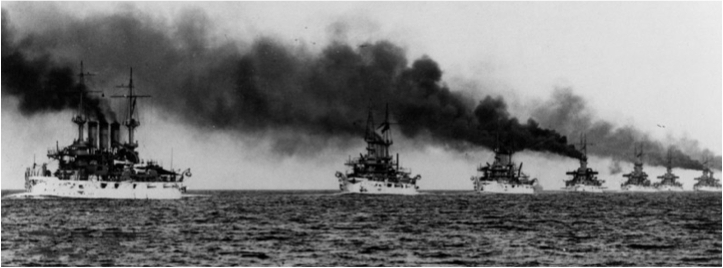Goddard Space Flight Center, Greenbelt, Maryland 20771
ENGINEERING COLLOQUIUM
Monday, September 19, 2011 / 3:30 PM, Building 3 Auditorium

James H. Bruns
"Theodore Roosevelt and the Birth of the Modern American Navy"
ABSTRACT --
"A good Navy is not a provocation to war. It is the surest guaranty
of peace."
President Theodore Roosevelt (1902)
The "Great White Fleet" consisted of sixteen new battleships, painted white except for the gilded scrollwork on their bows. The fourteen-month long voyage was a grand pageant of American sea power. The squadrons were manned by 14,000 sailors. They covered 46,000 miles and made twenty port calls on six continents. The fleet was greeted on its return by President Roosevelt, standing on the weather-deck of the presidential yacht Mayflower, off Hampton Roads, Virginia. The former assistant secretary of the Navy brought to the White House a deep conviction that only through a strong navy could a nation project its power and prestige abroad. At the turn of the 20th century, the United States was thrust into the mainstream of international affairs and gained status as a world power. Roosevelt stressed the upgrading and expansion of the U.S. fleet in order to protect American interests abroad. The four squadrons of warships embarked on a naval deployment the scale of which had never been attempted by any nation before the first round the world cruise by a fleet of steam-powered steel battleships. He felt a cruise of this magnitude would provide the American people with an example of U.S. naval preparedness, strength and range.
SPEAKER -- Jim Bruns has two personal connections with Theodore Roosevelt: A Garfield descendent, James R. Garfield (President James A. Garfield's son) was TR's Secretary of Interior, and upon TR's death in 1919, Garfield helped form the Theodore Roosevelt Association, an organization Bruns headed as President from 2007 to 2009.
Jim is also no stranger to the Goddard Space Flight Center, having served as Eleanor Roosevelt Senior High School's initial Science and Technology Center Instructional Coordinator. In this capacity, he was instrumental in creating the Research Practicum program and developing the Center's curriculum.
Jim then served as a Smithsonian curator and as the founding director of the National Postal Museum, the only Smithsonian museum built on schedule and under budget. After heading the museum for seven years director, Jim became the principal deputy to the Under Secretary for American Museum's and National Programs. Jim's last position with the Smithsonian was heading up the Institution's entire development and advancement department, a unit charged with raising $164 million annually.
After a 20 year career with the Smithsonian, Jim went to Atlanta to head up the Atlanta Historical Society, where he built the Centennial Olympic Games Museum, acquired the Margaret Mitchell House, helped with the acquisition and initial display of the Martin Luther King Jr. collection, and restored two other historic properties.
Jim then went to Oyster Bay, New York, to lead the Theodore Roosevelt Association.
In 2009 he was appointed as Vice President of Montclair State University, New Jersey's second largest state higher education institution.
In 2010 Jim and his wife, Christine, returned to the Washington, D.C., area to be closer to his children.
Colloquium Committee Sponsor: Brent Warner
Engineering Colloquium home page: https://ecolloq.gsfc.nasa.gov